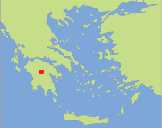|
Agia Paraskevi
of Arachamitai
2006 - 2007
2008
2010
2011
2012
2013
2014
Courtyard Building
South Wing
Temple/Altar
2015

|
AGIA PARASKEVI OF ARACHAMITAI
Report
of work conducted in 2014
The South Wing
This year work was continued
in the southern wing only in Room 6A, where work had begun already in 2013. The
room had in its last phase a floor made of stamped soil and a fireplace in the
centre. The floor layer and the cultural layer on top of it contained large
amounts of pottery and coins (including a silver coin hoard in a small jug), on
the basis of which we could date the last phase of use to the first century BC.
Below the uppermost floor level we found a thin second cultural layer and a
second, older stamped soil floor level, which we only managed to begin to
excavate.

 In
2014 we removed the second floor level, below which we uncovered a rich third
cultural layer. During this first phase of use of Room 6A there was no fire
place in the room and the room probably also included what later was made into
Room 6B. Instead there was along the middle of the west wall a low bench or
offering table (?). There was also an offering pit or bothros in the southwest
corner of the room. The bothros contained large amounts of figurines, lamps, and
pottery, all dating to approximately
between 325 and 275 BC. Some of the vases
which include a miniature vessel, kantharoi, guttui, one-handlers and a whole
series of round-mouthed juglets, were preserved nearly intact and were placed
upside down in the bothros. A Phoenician glass bead in the shape of a male head
and a bronze figurine in the shape of a ram belong to the more
spectacular finds from the bothros and the third cultural layer. In
2014 we removed the second floor level, below which we uncovered a rich third
cultural layer. During this first phase of use of Room 6A there was no fire
place in the room and the room probably also included what later was made into
Room 6B. Instead there was along the middle of the west wall a low bench or
offering table (?). There was also an offering pit or bothros in the southwest
corner of the room. The bothros contained large amounts of figurines, lamps, and
pottery, all dating to approximately
between 325 and 275 BC. Some of the vases
which include a miniature vessel, kantharoi, guttui, one-handlers and a whole
series of round-mouthed juglets, were preserved nearly intact and were placed
upside down in the bothros. A Phoenician glass bead in the shape of a male head
and a bronze figurine in the shape of a ram belong to the more
spectacular finds from the bothros and the third cultural layer.
 The
finds from the third cultural layer of Room 6A are similar in character and date
to those of the bothros, which must have been dug and filled during the
construction of this first phase of use of the room as the bothros partly
continues below the foundations of the southern long wall of the courtyard
building. Two coins were found in between the two stone layers of the small
bench or offering table, where they obviously had been placed in connection with
its construction. One of the coins is struck in Athens 350-300 BC, whereas the
second one in Elis 340-330 BC. The
finds from the third cultural layer of Room 6A are similar in character and date
to those of the bothros, which must have been dug and filled during the
construction of this first phase of use of the room as the bothros partly
continues below the foundations of the southern long wall of the courtyard
building. Two coins were found in between the two stone layers of the small
bench or offering table, where they obviously had been placed in connection with
its construction. One of the coins is struck in Athens 350-300 BC, whereas the
second one in Elis 340-330 BC.
 Room 6A was during its first phase of use between ca 325
and 275 BC clearly connected with cult activity. A more detailed study of the
very clear stratigraphy of this room will give us valuable information
concerning the local pottery chronology but also clarify the function of the
room during its last phase of use. Room 6A was during its first phase of use between ca 325
and 275 BC clearly connected with cult activity. A more detailed study of the
very clear stratigraphy of this room will give us valuable information
concerning the local pottery chronology but also clarify the function of the
room during its last phase of use.
The Courtyard Building
The Temple/Altar
|